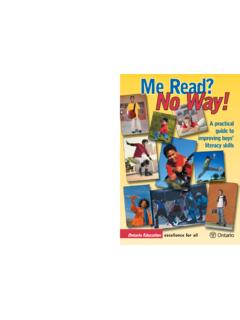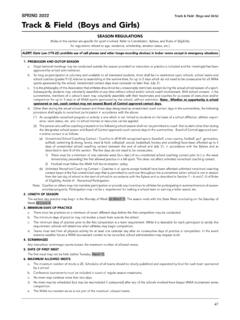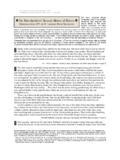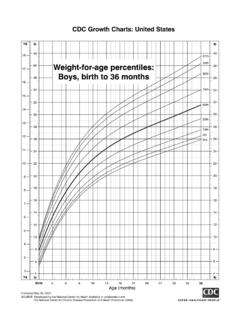Transcription of RFU REGULATION 15 – AGE GRADE RUGBY (APPENDIX 8) - …
1 RFU REGULATION 15 AGE GRADE RUGBY (APPENDIX 8) 1 Effective from 1 August 2021 RFU REGULATION 15 AGE GRADE RUGBY (APPENDIX 8) - Please note that between 1 August 2021 and 31 December 2021 these Rules of Play should be used by the current Under 15s Age GRADE boys , and the current Under 14s Age GRADE boys should refer to the Rules of Play for Under 13s (pursuant to RFU REGULATION ) UNDER 14s RULES OF PLAY boys ONLY Players and match officials must ensure that the applicable Rules of Play and RFU REGULATION 15 are observed when playing RUGBY at Under 14.
2 These Under 14s Rules of Play set out below are part of the Playing Pathway that aim to equip players with the skills they need to safely enjoy RUGBY union. The Age GRADE Rules of Play detail the level to which children of each can play to, coaches and match officials are encouraged to discuss necessary or desired pre-game and in-game modifications that reduce the playing level with the view to provide more appropriate learning opportunities. Any terms defined in these Rules shall have the meanings set out in the World RUGBY Laws of the Game. The key elements of the Under 14s Rules of Play are: Team numbers: a maximum of 15-a-side Maximum pitch size: 100 metres x 70 metres Ball Size: 4 Maximum minutes each half: 25 Contested 8 man scrum the can pick up the ball from the back of the scrum Introduction of the uncontested lineout Sin Bin: 5 minutes 1.
3 General: a) The object of the game is to score a try by grounding the ball on or behind the opponents goal line. A penalty try will be awarded if a try would probably have been scored but for foul or prohibited play by the defending team. b) Only infringements that affect the oppositions play should be sanctioned. If there is no effect, advantage should be played wherever it is safe to do so. 2. Teams: a) Under 14 RUGBY is played between teams of equal numbers of players, containing a maximum of fifteen players from each team on the pitch at any one time.
4 B) Eight of the players on each team will be forwards and form the scrum, with the remaining players forming the back line. RFU REGULATION 15 AGE GRADE RUGBY (APPENDIX 8) 2 Effective from 1 August 2021 c) Rolling substitutions are permitted and substituted players can be re-used at any time. Substitutions can only take place when the ball is dead and always with the referee s permission. d) Coaches are not permitted on the pitch when the game is in play and the referee is encouraged to advise and guide the teams and players. 3. Pitch Size: a) The maximum pitch size is 100 metres by 70 metres, plus 5 metres for each in-goal area, representing a full size pitch b) The referee and coaches may agree to reduce the pitch sizes provided that they agree it is safe to do so.
5 C) Adjacent pitches should be no closer than 5 metres. 4. Starts and Restarts: a) A drop kick from the centre of the half way line will be used to start each half of the match, and for all restarts after a score. After a score, the opponents of the team who scored will kick to the opposing team. b) The kicker s team must be behind the ball until it has been kicked and the non-kicking team must be at least 10 metres back from the half way line. c) If the ball does not travel 10 metres but is first played by an opponent, play continues.
6 D) If the ball does not travel 10 metres or is played by the kicking team before reaching 10 metres or is kicked directly into touch, the non-kicking team will have the choice of; i. A throw in to a scrum at the centre of the half way line. ii. The kick to be re-taken. iii. A throw in from touch. iv. Accept the kick. e) Where players of the kicking team are in front of the ball at the kick-off the non-kicking team shall have a throw in to a scrum on the half way line. f) If from the kick-off the ball is kicked into the in-goal, without having touched or been touched by a player and is then immediately touched down or made dead, or the ball goes into touch in goal, the non-kicking team has the choice of: i.
7 A throw in to a scrum by the non-kicking team at the centre of the half way line. ii. The kick to be re-taken. 5. Free Kick: RFU REGULATION 15 AGE GRADE RUGBY (APPENDIX 8) 3 Effective from 1 August 2021 a) Following the below offences a free kick will be awarded to the non-offending team: i. In the event that a ball carrier uses the squeezeball technique. ii If a player voluntarily falls on or over a player lying on the ground with the ball in their possession or voluntarily fall on or over players lying on the ground with the ball between them, or near them.
8 B) A free kick is a kick from hand. The kick must move the ball a visible distance out of the hand or along the ground. This can either be a tap by the player to themselves, or a kick to gain ground. The opponents must be 10 metres back, towards their own goal line and cannot start moving until the ball has been played. 6. Penalties: a) Following the below offences, a penalty will be awarded to the non-offending team: i. Foul play. ii. Offside. iii. When a tackler makes contact above the armpits. iv. When a player prevents an opponent from passing the ball immediately after a tackle.
9 B) When opponents are within 10 metres of the mark when a penalty kick is taken. 7. Passing: The ball may only be passed sideways or backwards. If the ball is handed to another player who is in front of the ball carrier or passed or knocked forwards towards the opponents dead ball line then a scrum is awarded to the non-offending team, unless advantage occurs to the non-offending team. In order to keep the game flowing, referees should play advantage wherever it is safe to do so. 8. The Tackle, Maul and Ruck: a) Only the ball carrier can be tackled.
10 B) The tackler must grasp the ball carrier below the armpits, on the shirt, shorts or around the legs. c) Support players must not stand either side and in close proximity to the ball carrier to prevent defenders from making the next tackle. d) When the ball carrier is held in contact and remains on their feet they may continue to progress forward. Once forward momentum has been stopped, the ball must be played away from the contact area. e) When the ball carrier is not taken to ground, the opponent may contest the ball by grabbing it.
















